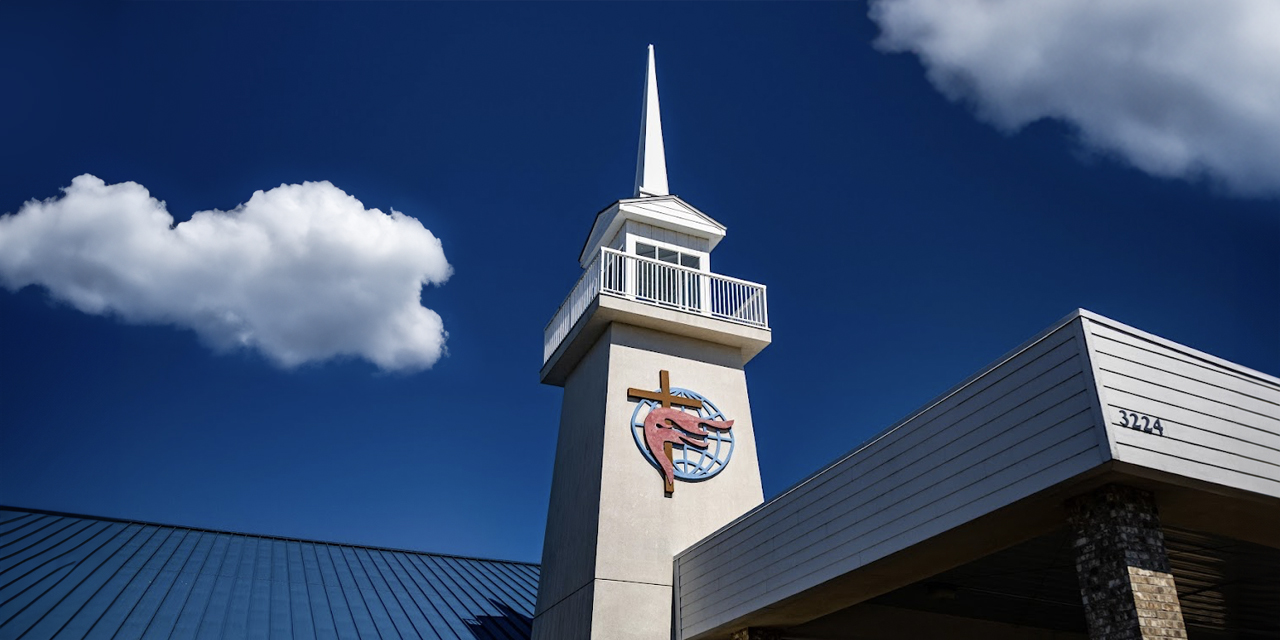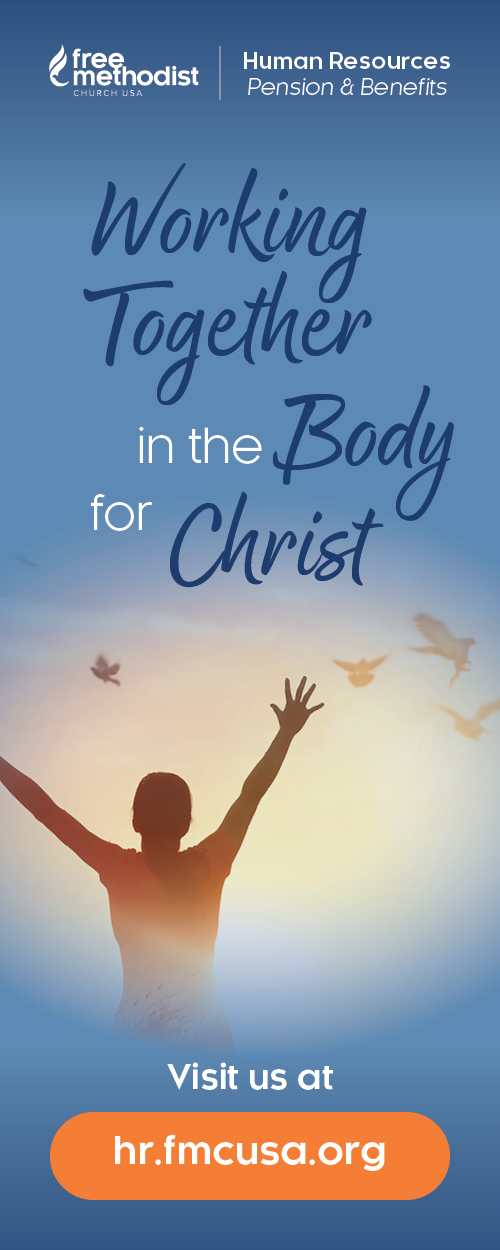
Alex Mace
Alex Mace is an ordained elder in the Central Region Conference and the lead pastor of Northwest Free Methodist Church in Wichita, Kansas. He previously served at Milan Free Methodist Church as associate pastor. Alex and his wife, Mackenzie, have three daughters: Ansley, Kiah, and Hollis.
By Alex Mace
In 2021, I became lead pastor of Northwest Free Methodist Church in Wichita, Kansas. I brought experience of two supporting pastoral roles, but this was my first time as “lead.” I felt prepared for this call.
Yet I also was aware this church had once been growing rather rapidly and had built a church building (pictured above) in the growing affluent area of Wichita. However, as I walked into the lead pastor office door, only 30% of attendees were left on the rosters from the congregation’s highest average attendance point. What I did not realize was the complications a physical building can add to a church in decline. Here is my story and some things I learned.
Coming into a declining faith family at Northwest brought significant challenges to me. I had been a part of a declining church, but serving as the lead pastor was different than my earlier life experience of growing up in an aspiring megachurch that went from over 1,000 to below 500 in two years.
The world shifted since that time with Christendom falling apart in America. The traditional “Field of Dreams” approach (if you build it, they will come) was no longer working. We had a nice church building. A mile to the west of us is a major shopping center (Target, Sam’s Club, Walmart, etc.). We are surrounded by subdivisions, and we are less than a quarter mile from a large high school. Yet, if you were to plot where we had people attending from within a mile of the church, only one family was attending.
_
“How do we move this church forward on God’s mission, and how do we impact the community?”
_
This created some big questions, beginning with: How do we move this church forward on God’s mission, and how do we impact the community?
There are books upon books with definitions of mission out there. I prefer Randy Woodley’s definition from “Mission and The Cultural Other”: “Our mission is to be inviting others into the community of Jesus, regardless of what it is called and regardless of whether or not they recognize him. We do this by ever extending the circle of joy and acceptance in our particular context.”
For me, the mission is about showing that God’s love and acceptance are for everyone even if they don’t recognize Jesus. For the majority of post-1980s church history, mission has often focused on numbers: giving, people, baptisms, and buildings. This has created a problem where churches grew from the 1980s onward with people who were well-intentioned and loved Jesus, but the growth rate slowed down. The quest for bigger numbers has often driven decisions to narrow the circle of acceptance. It is easier to keep what you have if the walls of escape are high. These decisions are counter to widening and increasing the circle of joy and acceptance in Jesus.
In the church, decisions were made to build and hire staff, not bad things, but often buildings and staff sacrifice mission for maintaining the staff and the buildings. Starting conversations about mission and impacting our community often created roadblocks.
_
“… it was hard not to be discouraged.”
_
First, we continued to have families leave the church. Even though some left over long-standing issues, it was hard not to be discouraged. My self-talk began to include thoughts like: Am I a bad leader? Was this the right position to take for a first-time lead pastor? What am I doing in Kansas?
With every family that left we had a declining budget, with a very expensive building. The building had 12,000 square feet and a 50-foot ceiling in the lobby; beautiful … but not efficient.
We had aging technology. Every Sunday I prayed the projector wouldn’t die.
Our mortgage to the conference was $1,650 a month, our monthly utilities were over $1,000 a month.
The building cost and my salary were 85% of the church budget.
_
“It felt like I was Sisyphus, who cheated death.”
_
The realities of a small church struggling in the face of continued decline were onerous. It felt like I was Sisyphus, who cheated death. We would begin to talk about the mission and something else would change. It felt like I was on a tightrope being moved by an invisible hand — just aiming to keep balance so the church could stay afloat.
In July 2022, it became clear that we had a building and property that were dragging down the mission. The church would never be on mission as long as we held onto our building.
The cost of running the building was consuming funds that should have been used to extend the circle of joy and acceptance of Christ. The funds, however, kept going to maintaining a building in a part of town where we had very few people attending from the immediate housing around the church.
_
“The cost of a building is not just financial; it’s the people to care for the building as well.”
_
But it wasn’t just the financial cost of the building. We barely had volunteers to help clean the bathrooms, let alone the rest of the building. The building sat on nine acres of property that we had to manage and care for with very few people to manage and care for. The cost of a building is not just financial; it’s the people to care for the building as well.
When I first realized it was either the building, the mission, or the pastor, I approached our lead delegate, Jared, and I asked him for his opinion on this matter. I explained that I thought selling the building was the best case going forward for the future of the church. In that initial conversation, he encouraged me to make sure that our church is following where God is leading.
In August 2022, I presented to the board that we needed to investigate selling our building. What I didn’t realize then is that the tightrope got longer the minute I announced that in our board meeting. We began a two-month window of praying and waiting that involved deep emotions beyond the focus on the building.
_
“It went from heartbreak to joy to heartbreak quicker than anyone could prepare.”
_
In September, Jared — our longtime delegate and board member whom I called the spiritual heart of our church — died unexpectantly from a heart attack. The funeral was packed and powerful. It was a meaningful time for our membership. At the end of that month, we celebrated 40 years of ministry, another meaningful note in our story. Then came November when we held a vote to sell the church. It went from heartbreak to joy to heartbreak quicker than anyone could prepare.
This is where I have to confess, I don’t think I handled the sale of this property well. In retrospect, I wonder if we:
- Missed out on opportunities.
- Made this process too long.
- Could have been more agile.
With the best intentions, I attempted to make sure that everyone was able to voice an opinion and share their thoughts at our society meetings. Perhaps having three different votes on selling the church building to confirm the continued commitment of the church body brought more complications than clarity. I believe we could have reached that sense of agreement sooner had we moved more quickly on the sale of the building and the challenge going forward.
Instead, when the vote to sell the property did pass, we lost more families. If we couldn’t afford our building before, we certainly couldn’t afford it now. This is always the risk of making hard decisions. Avoiding the decision does not lower the risk.
_
“You will not avoid people acting like their society tells them to react.”
_
The majority of Americans have been trained to be consumeristic. You will not avoid people acting like their society tells them to react. But if it’s a question of consumer loyalty or following Jesus, choose Jesus.
Throughout this process, I have started thinking about what is essential for the mission of the church. Do we need the typical approach of the past 40 years with a focus on buildings and programs? Or can we reduce extending joy and acceptance to a few minimums?
Here are some thoughts about our congregation’s decline and future and the future of the church in the United States:
- Neglecting the mission removes us from renewal.
As a pastor, I felt it difficult to bring our focus back to God’s mission. One way this distraction became visible was a lack of history celebrating or expressing life changed by the Spirit of God on Sundays and beyond. When we lose focus on God’s mission, there will never be a compelling reason for the church to change its direction. Paul reminds us in Romans 12:2 (CEB), “Don’t be conformed to the patterns of this world, but be transformed by the renewing of your minds so that you can figure out what God’s will is — what is good and pleasing and mature.”
_
“When a church body enters into that sense of habit, we are at risk of moving the mission to the basement.”
_
As humans, we are creatures of habit, and familiarity brings complacency. A few people in every gathering have that unquenchable desire to improve and get better. This helps us avoid complacency as a group, but when a church body enters into that sense of habit, we are at risk of moving the mission to the basement. If the church you are pastoring — or in which you are involved — is in decline, and you are working to bring the mission up to the living room or the front porch, you will most certainly lose people who desire familiarity over the mission of God. For everyone who has left our church, I pray that they enter into new spaces where their hearts can see the mission of God as active and powerful — that they feel they’ve joined something to give their life to.
- Rethink the essentials to avoid complacency and opportunity.
In Acts 2:42, we are given this portrait of the first beginnings of the church: “The believers devoted themselves to the apostles’ teaching, to the community, to their shared meals, and to their prayers” (CEB).
_
“We will certainly need space to gather, but do we need the trappings of traditional churches in America?”
_
The essentials for the early church were community, teaching, meals, and prayer. What might we consider essentials for the modern church? Have we devoted ourselves to our community, to the teachings of Christ, to the shared table, and prayer? What is needed to do that? Could this be done in homes, parks, and coffee shops? We will certainly need space to gather, but do we need the trappings of traditional churches in America? Could a building that feels comfortable — even like home — possibly be dragging down the mission?
- “Pray without ceasing” (1 Thessalonians 5:17 KJV).
Throughout this journey — facing decline, having board members die, and the sadness of families leaving the church — I would not have been able to do it without prayer. Even in those desperate moments when it felt like there was no good way, prayer was always available to me. I was reminded early on by a quote from John Climacus in “The Ladder of Divine Ascent”: “Let your prayer be completely simple. For both the publican and prodigal son were reconciled to God by a single phrase.” Sometimes my prayers were simply for God to give me strength.
We still don’t know what the future holds for our local church, but we are in the process of refocusing on mission and community. We seek to bring Christ’s joy and acceptance to Wichita.
+

Alex Mace
Alex Mace is an ordained elder in the Central Region Conference and the lead pastor of Northwest Free Methodist Church in Wichita, Kansas. He previously served at Milan Free Methodist Church as associate pastor. Alex and his wife, Mackenzie, have three daughters: Ansley, Kiah, and Hollis.









